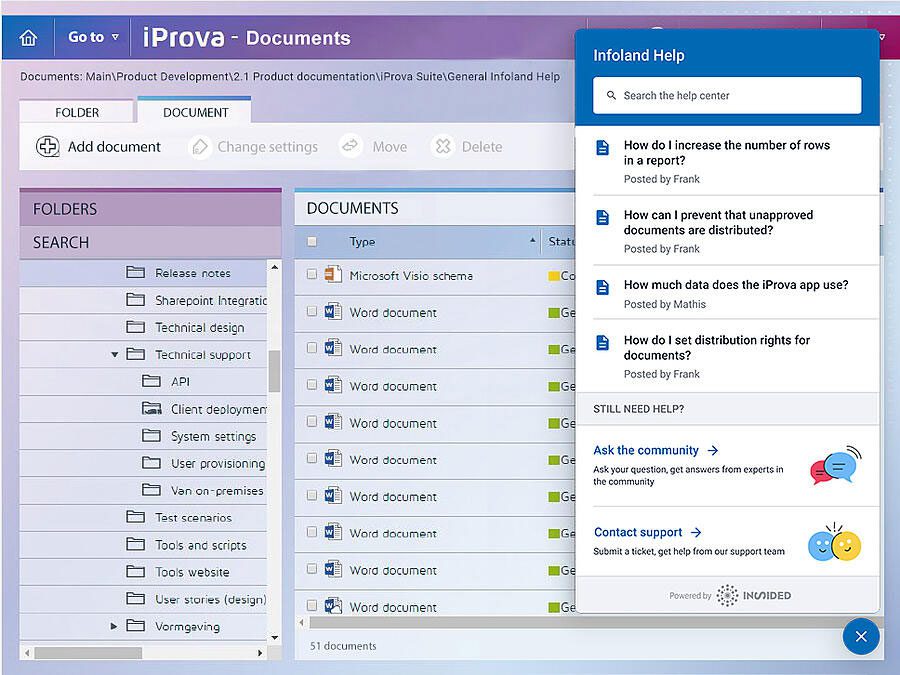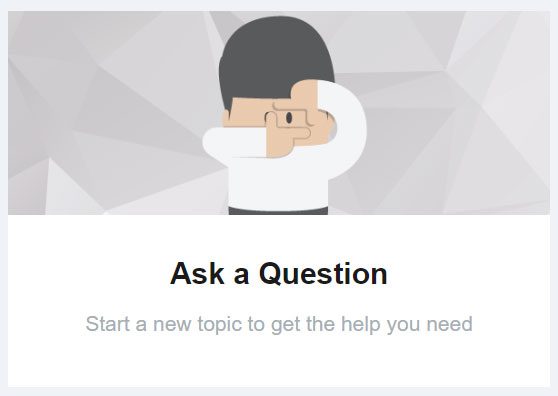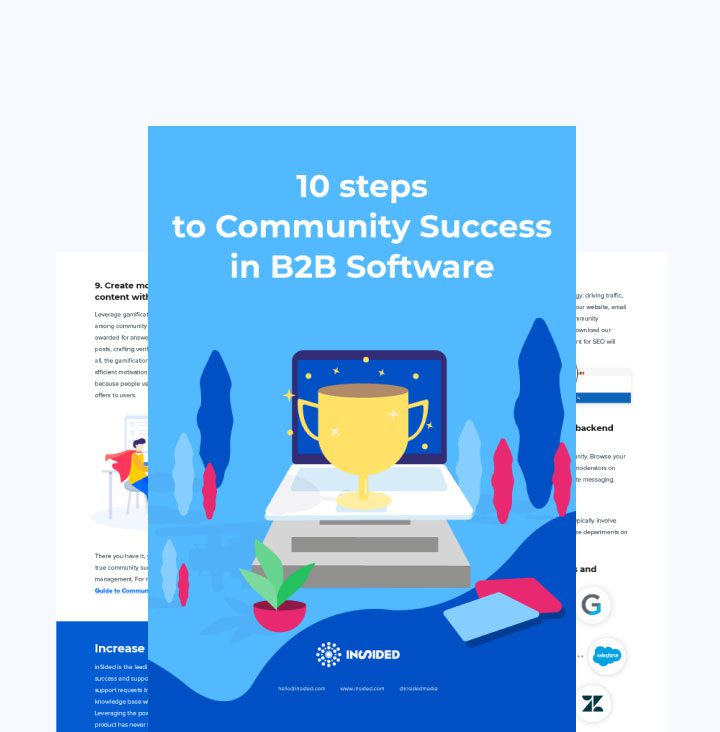Originally published on inSided.com on September 18, 2019.
A couple of weeks ago we posted a blog on 3 reasons why online communities are vital for effective Customer Success. Well, if that was the why, this the how.
You want your users to get the most out of your product while being happy customers and true advocates, right? Our aim is to show you exactly how an online community can be used to scale your Customer Success efforts effectively while making sure you are maximizing your community’s potential.
Here are 5 ways to do just that:
1. Ensure your customer success content is readily available
It may sound simple, but make sure you provide all the information your users need to achieve their goals. Your customers bought and started to use your product because they had a need. By providing all possible information that helps them get the most from your product within your community, you will create trust and loyalty, while greatly improving the customer experience.
2. So, you’ve got all the relevant information available, but how do you present it in your customer community?
It’s all well and good making all of your customer success content available, but if customers can’t easily find it, it may as well not be there at all. Think about what your users require in the various stages of their customer journey, which products you offer, and which steps they need to take to get maximum value from your product.
Of course, if customers really can’t find the content they are looking for they can always easily post a question to be answered by your community manager, your customer service/success team, or by another member of the community. This, in turn, means your knowledge base is constantly updating with both your company content and user generated content—increasing the likelihood of your customers being able to self-serve.
Here are a few essential steps to follow to make sure your customers can find the information that is relevant to them:
- Have a category dedicated to onboarding materials for new customers with all the relevant information they need so they will reach their first milestones as quickly as possible and get to know the community right from the start of their customer journey. An example of this can be found in our own inSpired Community—we help customers onboard as smoothly as possible and highlight common mistakes they should avoid. By making the community a central place for onboarding, we are able to bring down the average implementation time from 12 to 4 weeks, as customers can easily self serve.
- Provide a recommended content section on your homepage and in different category pages to assist your users by providing the most searched for or most impactful content. Have a look at how Cumulus has picked their most valuable content and added it to the recommended content section.
- Implement in App support: Use our out of the box embeddable widget to help your customers wherever they get stuck by providing them with information that is relevant to the page they are visiting. See for instance how Infoland uses relevant content from their community in iProva, their quality management system:

- Create articles to make sure important content stands out and ranks higher in search results.
- Highlight clear calls to action to stimulate Q&A. Like AIMMS does with with a quick link in their community:

- Finally, use quicklinks to really build a one stop shop for your customers so they can find everything they need in one place. Thinkwise uses Quicklinks to easily guide their customers to important resources they have available. This means the community can be the main entry port for customer requests and questions.
3. Encourage engagement and advocacy
In B2B SaaS companies, customers are eager to learn from each other and discover how they can improve based on the best practices of others. Events are one way to let them get in touch with each other, but they can be costly and difficult to organise. You could also create social media groups for your users to interact, however it’s important to remember that you do not own the content that is created. On the other hand, in your community, your customers can get in touch with each other whenever they want, you own the content, and their findings/advice will always be available for customers old and new.
Encourage your customer base to engage with each other by sending a community newsletter, ask your contacts to share their best practices (interview them or create a template), give examples of how they use your products and how they calculate the value.
As a bonus, this content builds trust with your prospects and can encourage them to opt for your solution. Make sure you reward all input by following up with personal messages, show interest by asking follow-up questions and mentioning other users so customers who make the effort to share knowledge get the audience they deserve. Don’t take this lightly—as we all know, customer engagement is an important way to drive retention.
Another tip to stimulate engagement and help to reduce churn is to invite your true advocates or customer experts to a closed group on the community, where they can have more in-depth discussions with you and each other. This will make them feel more acknowledged, which might lead to more bonding and customer loyalty, while also giving you invaluable feedback on your product.
4. Integrate your Community with your CRMs and ticketing systems/Use your community in your customer health measurements
Given that engagement is an important factor influencing customer retention, engagement metrics should be a part of your overall customer health score. Analyzing who is active on your community and their interaction is important as engaging with you as a brand is key to retention. In order to analyze this, our integration with your CRM system, like SalesForce, makes keeping track super easy. Check out our blog on getting the most from inSided’s integration with Salesforce for more information.
5. Increase product adoption by promoting features and building the things your customers need
You want to make sure that your customers are successful and get the most value out of your product. Make sure your customers can always find the latest feature updates and read what’s coming up on your roadmap. Explain why you built certain features, how to use them to their full potential and what the proven value is, just like AIMMS have done. Your customers will, therefore, feel the community is a place where they can share their opinion about these features or make ideation requests.
Make sure your Product Owners are active on the community so they can explain their point of view first hand and give customers direct feedback. The benefit for your Product Team? They get all their product feedback in one central place, can easily ask follow up questions to a larger crowd and can see discussions between your customers.
This approach makes sure your customers are more encouraged to make use of the features you offer and feel more engaged, while your product team can focus on the most important things for your customers. At the Webroot Community, for example, customers can file a request and they can immediately see the status of it in their ideation category.
Your community is the key to scaling Customer Success
A lot of the points above, from creating engagement to helping your customers when they have questions to giving the information they need during onboarding and at critical phases of their journey are probably always incorporated in your success approach.
The real benefit of a community is that it helps you to scale. Your Customer Success Manager no longer only gives an update to their own customers, via the community they can reach all your customers at once—and the content will always be available for future customers.
The result? They can handle more customers and are able to gather more insights from their customers by analyzing their questions and interactions on the community. What’s not to love?
For more information on how to make sure your online community drives real benefits for your users, and your business check out our 10 Steps to Community Success.

Download 10 Steps to Community Success in B2B Software
Find out the 10 steps needed for a successful B2B customer community.
Learn More
Looking create a single destination for your customers to connect, share best practices, provide feedback, and build a stronger relationship with your product? Schedule a demo to learn more.

